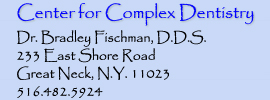 |
 |
In recent years, we have seen a marked increase in the development of esthetic materials, which include ceramic and plastic compounds. These materials mimic the appearance of natural teeth and are more esthetically pleasing where they will be visible.
But the advent of these new materials has not eliminated the usefulness of more traditional restorative materials. Their strength and durability make them useful for applications where they must withstand extreme forces that result from chewing, i.e., in the back of the mouth. These traditional materials include gold, base metal alloys and dental amalgam. Dental amalgam, a mixture of mercury and other metals, remains the single most commonly used filling material.
Some have raised concern about amalgam because of its mercury content. The concern is intuitive but unfounded. It should be clearly understood at the outset that dental amalgam and mercury are not the same thing, and their characteristics and properties are not interchangeable. Chlorine is a toxic gas, but when combined with sodium, a toxic metal, table salt is the resulting product. No one compares the proprieties of table salt to either chlorine or sodium. Similarly, when mercury is combined with other metals to make dental amalgam, it is safe for use in accepted dental applications.
Dental amalgam Dental amalgam has been used for more than 150 years. is the most thoroughly researched and tested restorative material among all those in use. After all that time, and considering the billions of amalgams that have been placed, we would expect to see some epidemiological evidence if there were any ill effects on patient health. Instead, we have fewer than 100 cases of documented localized allergic reaction.
Thousands of dentists and their staffs work with dental amalgam every day, with no demonstrated ill effects on their health. Dentists are exposed daily to a number of materials, often at dosage levels and durations much higher and longer than a patient, so it is likely that any adverse outcomes would be manifested first in the dentist. Again, we simply have not seen them in the case of amalgam.
ADA scientific investigators have examined whether enteric bacteria might have the ability to convert inhaled or ingested mercury to more toxic organic (methyl) mercurials. They hypothesized that, if bioconversion did occur, then occupationally exposed dentists would show higher levels of organic mercury in blood than non-dentists. Their research showed no significant difference in organic mercury levels. Higher blood organic mercury levels did not correlate with the number of amalgams in an individual’s mouth, nor did it correlate with the number of amalgams placed or removed by the dentists. However, organic mercury did correlate well with the frequency of seafood consumed. (Chang S-B 1992, 1990, 1988, 1987; Siew C, 1987).
The major U.S. and international scientific and health bodies, including the National Institutes of Health, the U.S. Public Health Service, the Food and Drug Administration, the Centers for Disease Control and Prevention and the World Health Organization, among others, have all stated that dental amalgam is a safe restorative material. Indeed, the Alzheimer’s Association, the Autism Society of America, the National Multiple Sclerosis Society and the American Academy of Pediatrics all have explicitly stated that there is no scientific evidence linking dental amalgam with any known disease or syndrome that those groups track. These organizations, which devote their entire efforts to understanding the diseases they represent, surely would not make such statements without confidence that they are true.
Not only is dental amalgam safe, it remains a valuable restorative option for dentists and their patients because it is so effective. At present, there is no direct restorative material that works as well as amalgam for certain types of fillings. Amalgam, unlike other direct restorative materials, tolerates moisture during placement. That is important for fillings in places that are difficult to keep dry, like below the gum line. Amalgam is also still the strongest, most durable direct restorative material for large, load-bearing restorations on the posterior teeth. Certain indirect restorative materials, like gold and porcelain, may also be suitable for these situations.
********************
(Excerpted from the statement by the American Dental Association to the Government Reform Committee United States House Of Representatives on "Mercury In Dental Amalgams: An Examination Of The Science" November 14, 2002)
Dentures | Extreme Makeovers | Doctor's Credentials | Map & Policies | Contact Us
Home | Professional Referrals | Tidbits for Dentists | Newsletters for MDs